M3AAWG June 2022 - DNSSEC & DNS Debugging
Welcome to the DNS & DNSSEC debugging workshop at M3AAWG June 2022!
In this workshop we will present tools and procedures on how to troubleshoot DNS and DNSSEC issues. Being able to find the cause for an DNS or DNSSEC malfunction is not only useful to find issues with your own DNS deployment, but also to be able to assess DNS name resolution problems on external domains that has a negative impact on your own infrastructure (for example mail delivery).
In this workshop we especially focus on changes in the DNS ecosystem that happend in the recent years, such as the DNS-Flag-Day 2020, DNS-Cookies or alternative DNS transports such as DNS-over-TLS or DNS-over-HTTPS.
This workshop is separated into several chapters. Each time a new chapter starts, the trainers will enable the notes and instructions for the chapter on this webpage. If you are missing the chapter information on this webpage, use the RELOAD function of your web-browser to load the new content.
1 DNS Security and IP Fragmentation Report
- Report for German Federal Office for Information Security: "IP Fragmentation and Measures against DNS Cache Poisoning (Frag-DNS)" https://www.bsi.bund.de/SharedDocs/Downloads/DE/BSI/Publikationen/Studien/Frag-DNS/Frag-DNS-Studie.pdf
2 Source Code of the tools used in this workshop
The source code of some of the tools shown during the workshop can be found in the github repository for this workshop: https://github.com/sys4/m3aawg-dns-and-dnssec-debugging
3 Knowing your tools
3.1 Querying the DNS with "dig"
digis the standard tool to send DNS queries.- It replaces the older (and obsolete
nslookup)- stay away from
nslookup, it is old, deprecated and has know bugs that will not be fixed - It uses it's own resolver library, which can create results differently from the operating system resolver
- It does not show all the useful data in a DNS response (like EDNS)
- It cannot work with DNSSEC
- stay away from
- For troubleshooting purposes, we recommend to use the most recent
version of
dig, as it includes additional troubleshooting capabilities (like EDE error codes) compared to older versions.- The current version of
dig(June 2022) ist 9.18.3 (https://ftp.isc.org/isc/bind9/9.18.3/) - On the training lab virtual machines we use a version
9.11.36-RedHatthat has support for extended DNS error codes and DNS cookies backported
- The current version of
- The output of
digresembles the structure of DNS packets on the wire
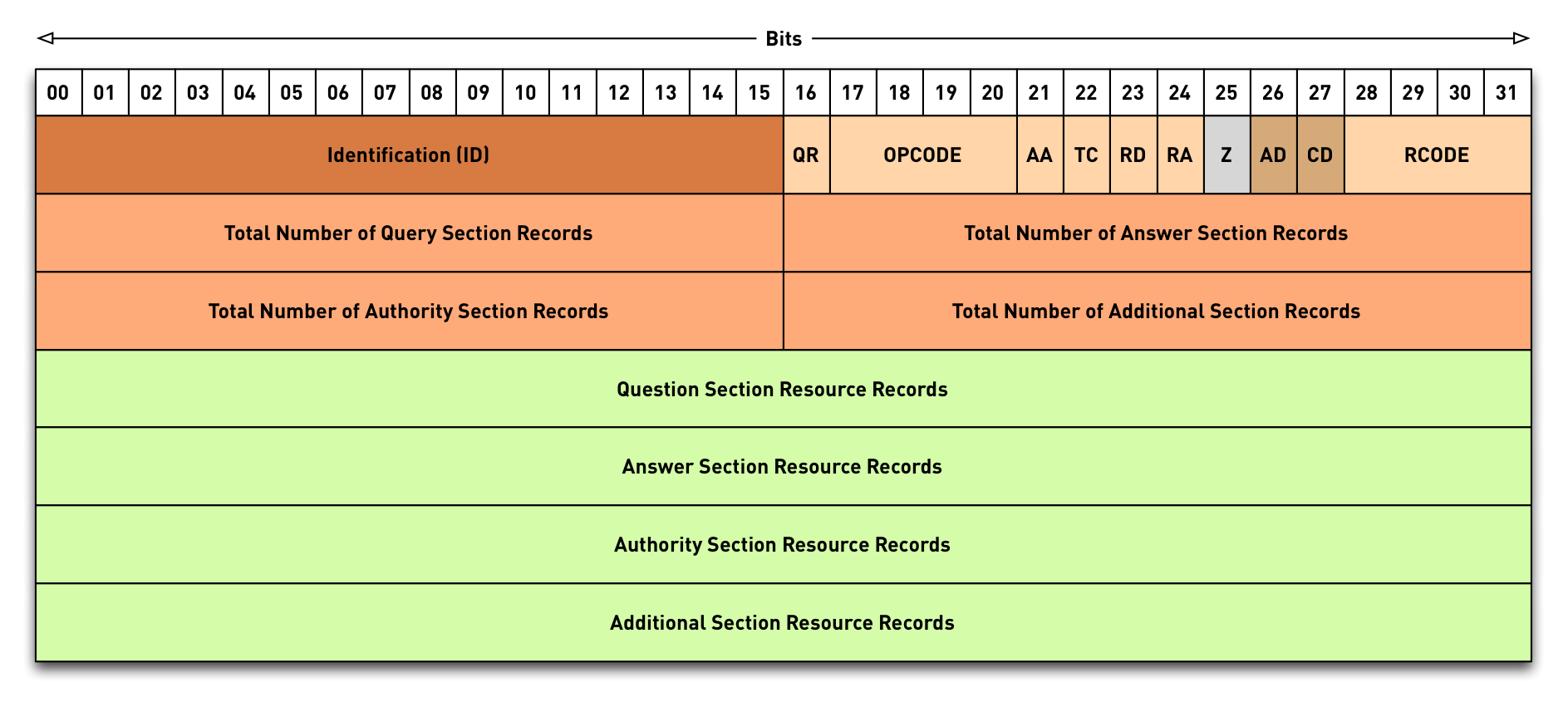
- The
digoutput explained
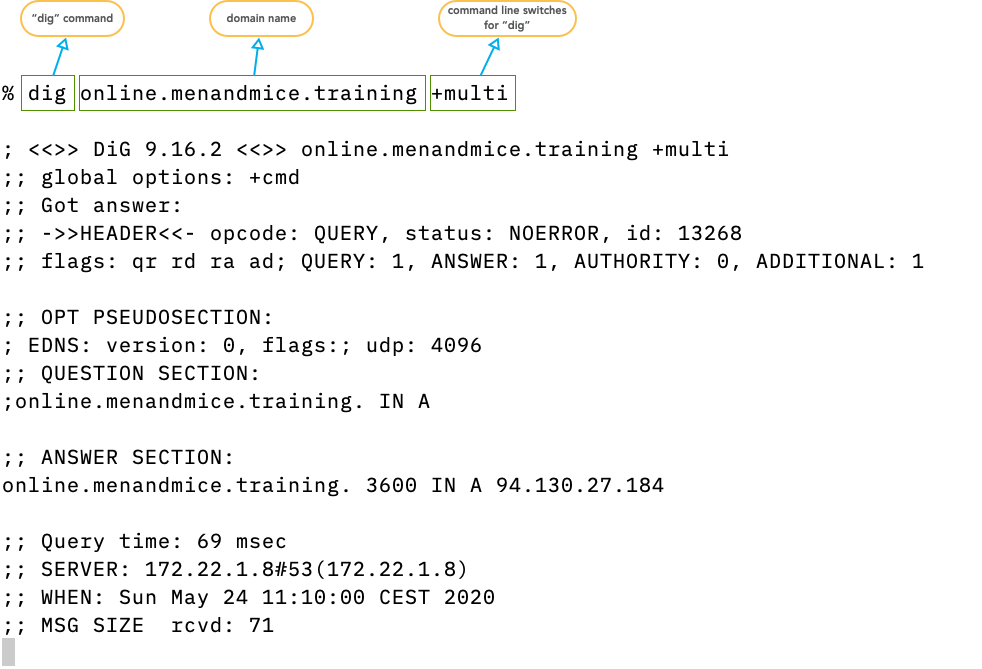
- The DNS data is separated in sections

3.1.1 Exercise
- Login to your virtual lab machine
- Install the
digtool% sudo dnf install bind-utils
- Use
digto answer the following questions.- What is the IPv4 address of
ftp.isc.org? usedig ftp.isc.org - What is the IPv6 address of
ftp.isc.org? usedig AAAA ftp.isc.org
- What is the IPv4 address of
3.2 DNS Packet Header
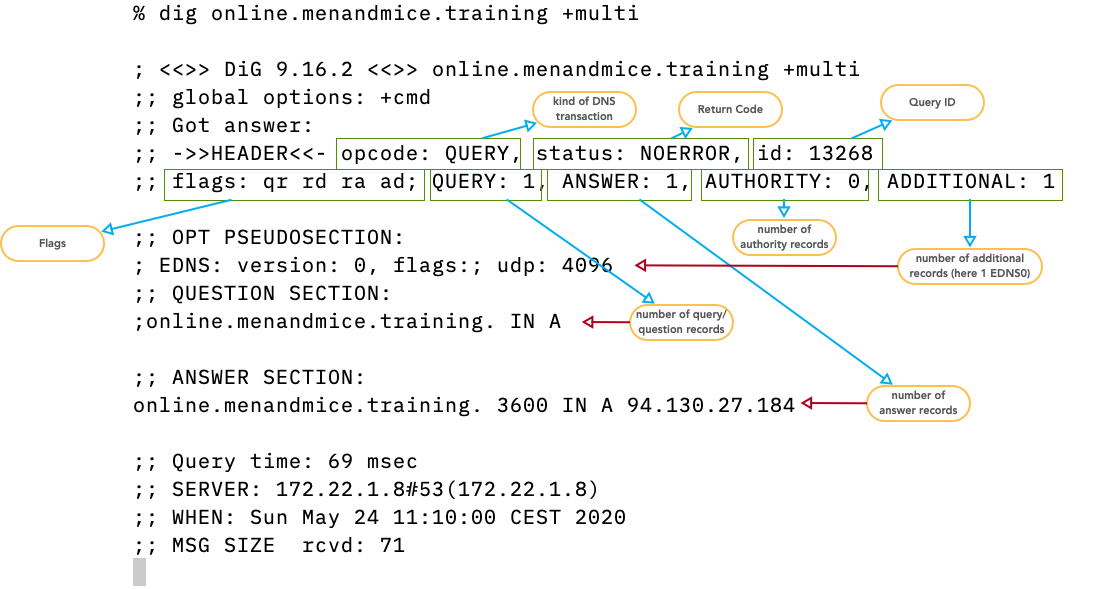
- opcode:
query,notify,update,DSO… see IANA registry for DNS OpCodes - status/rcode:
NOERROR- The operation was successfulNXDOMAIN- The domain name requested does not exist (or is not delegated)SERVFAIL- Some remote DNS server failure or DNSSEC validation failureFORMERR- The query was not correct DNSREFUSED- This server has an access control list that forbids the answer to this clientNOTIMPL- A feature used/requested that this server does not implementBADCOOKIE- Bad/missing Server Cookie
- queryid: 16bit value to sort DNS answers to DNS queries
- flags: Information on the query and the answer
(see
IANA registry for DNS Header Flags)
AAAuthoritative answer - answer is coming directly from an authoritative serverTCTruncated - answer does not fit into the advertised UDP packet size, please re-query over TCPRDRecursion desired - this is a query from a client machine, please provide a full complete answer (no referral please)RARecursion available - this answer comes from a DNS resolver that is willing to accept queries withRDflag set
- DNSSEC flags: AD- and CD-Flag
ADAuthentic data - the DNS resolver sending this answer has performed a successful DNSSEC validation on the data. If we trust the resolver, we can trust the dataCDChecking disabled - a client asking a DNSSEC validating DNS resolver to not perform DNSSEC validation but to pass all DNSSEC data unaltered (even if the data is invalid). Used for troubleshooting DNSSEC issues.
- QUERY: Number of query resource records (usually one)
- ANSWER: Count of DNS resource records in the answer. Can be more than one. Can be zero if no data is available for the query.
- AUTHORITY: Number of authority records in the answer. Can be a SOA-Record (for negative answers) or NS-Records for referrals or positive answers. Many modern DNS server only fill the authority section if required by the protocol to keep answer packets small
- ADDITIONAL: Additional resource records that not have been requested but might help with the name resolution, and the EDNS (Extended DNS) OPT-Record (see RFC 6891 Extension Mechanisms for DNS (EDNS(0))
3.2.1 Exercise
- Use
digto answer the following questions.- What is the returncode of
dig dns.google.com - What flags are set on this query?
- What is the QUERY-ID?
- How many records are in the answer section?
- What is the returncode of
3.3 Extended DNS OPT Section
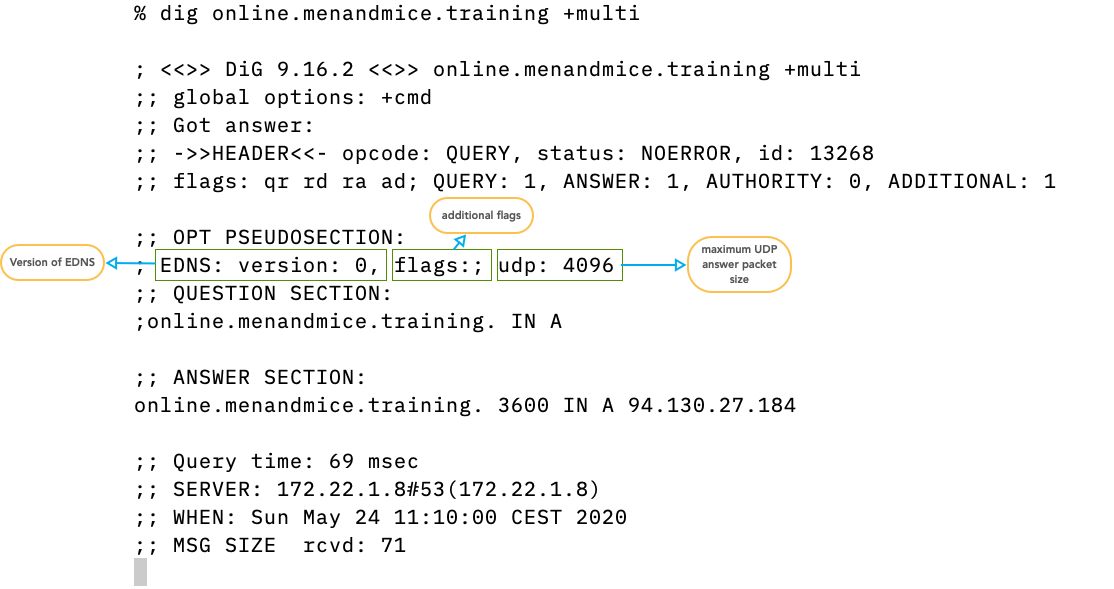
- EDNS Version 0 is the current version
- New Versions are being discussed in the IETF
- Additional EDNS flags.
DO- DNSSEC OK, this DNS client supports DNSSEC records - Maximum UDP answer packet size in byte as negotiated between
digand the DNS server/resolver. Current default is 4096, must be between 512 and 4096. The default changed to 1232 on DNS flag day 2020 - RFC 8914 - Extended DNS Errors defines a way to deliver additional
error information in an DNS response. It is already implemented in
the latest versions of
digsince version BIND 9.16.4. Some DNS resolver on the Internet (like Cloudflare) do support EDE messages: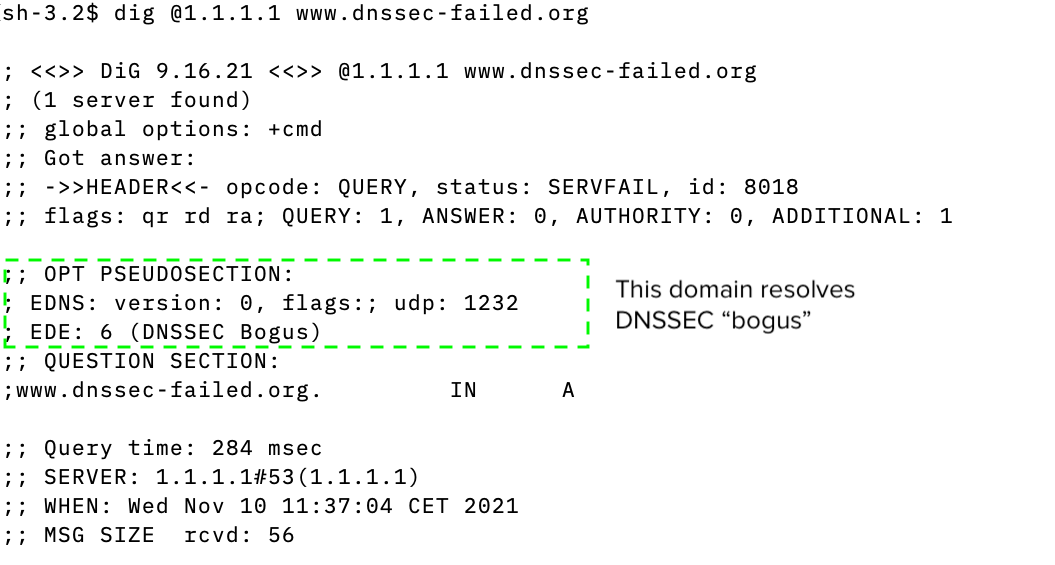
- RFC 7873 Domain Name System (DNS) Cookies great a lightweight
session between a DNS requester and a DNS responder (DNS client and
DNS resolver or DNS resolver to authoritative DNS server)
- DNS cookies prevent certain kind of DNS spoofing and denial of service attacks
- Support for DNS cookies can be seen in a DNS response EDNS section
$ dig @ns5.tidelock.de dnssec.works SOA +cookie +multi ; <<>> DiG 9.11.36-RedHat-9.11.36-3.el8 <<>> @ns5.tidelock.de dnssec.works SOA +cookie +multi ; (2 servers found) ;; global options: +cmd ;; Got answer: ;; ->>HEADER<<- opcode: QUERY, status: NOERROR, id: 18486 ;; flags: qr aa rd; QUERY: 1, ANSWER: 1, AUTHORITY: 2, ADDITIONAL: 1 ;; WARNING: recursion requested but not available ;; OPT PSEUDOSECTION: ; EDNS: version: 0, flags:; udp: 1220 ; COOKIE: 0229126cd6b3fa8e0100000062a6f806171fd91580e27b61 (good) ;; QUESTION SECTION: ;dnssec.works. IN SOA ;; ANSWER SECTION: dnssec.works. 1800 IN SOA ns3.myinfrastructure.org. hostmaster.strotmann.de. ( 3454 ; serial 86400 ; refresh (1 day) 7200 ; retry (2 hours) 3542400 ; expire (5 weeks 6 days) 3600 ; minimum (1 hour) ) ;; AUTHORITY SECTION: dnssec.works. 1800 IN NS ns3.myinfrastructure.org. dnssec.works. 1800 IN NS ns5.myinfrastructure.org. ;; Query time: 14 msec ;; SERVER: 2001:19f0:5001:df:76d7:5703:ba0a:e220#53(2001:19f0:5001:df:76d7:5703:ba0a:e220) ;; WHEN: Mon Jun 13 08:40:38 UTC 2022 ;; MSG SIZE rcvd: 190
3.3.1 Exercise
- Use
digto answer the following questions.- What is the maximum allowed UDP answer size in bytes for
dig @ns8.dnssec.works ch txt hostname.bind?
- What is the maximum allowed UDP answer size in bytes for
3.4 Answer Section
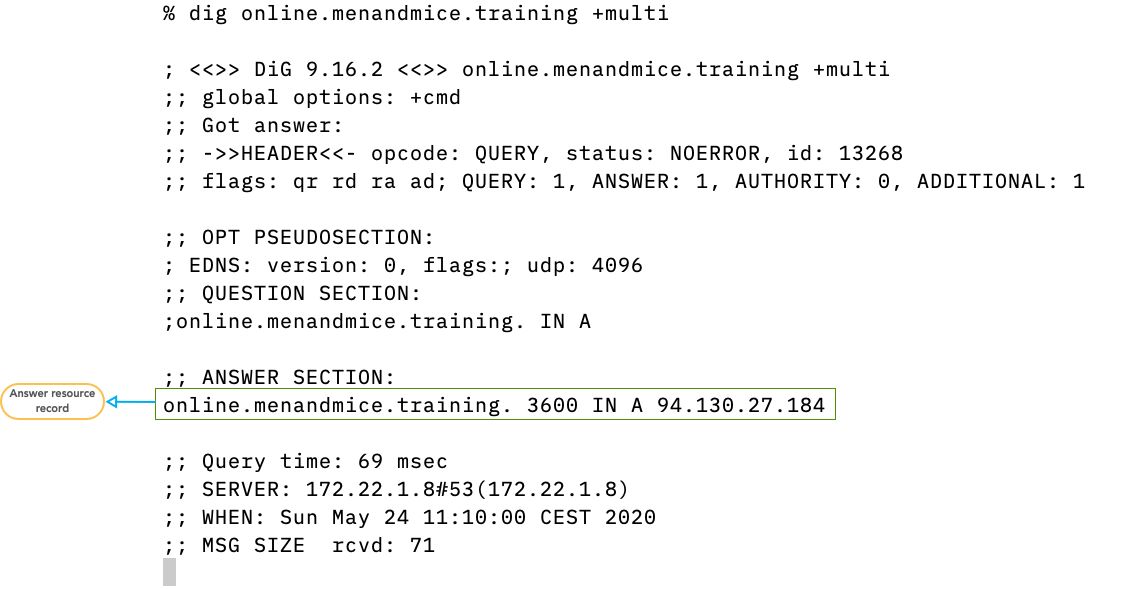
- The answer section contains zero (if there is no data available), one or more DNS resource records that match the query
3.4.1 Exercise
- Use
digto answer the following questions.- How many MX mailservers does the domain
twitter.comhave? Trydig twitter.com MX
- How many MX mailservers does the domain
3.5 Authority Section
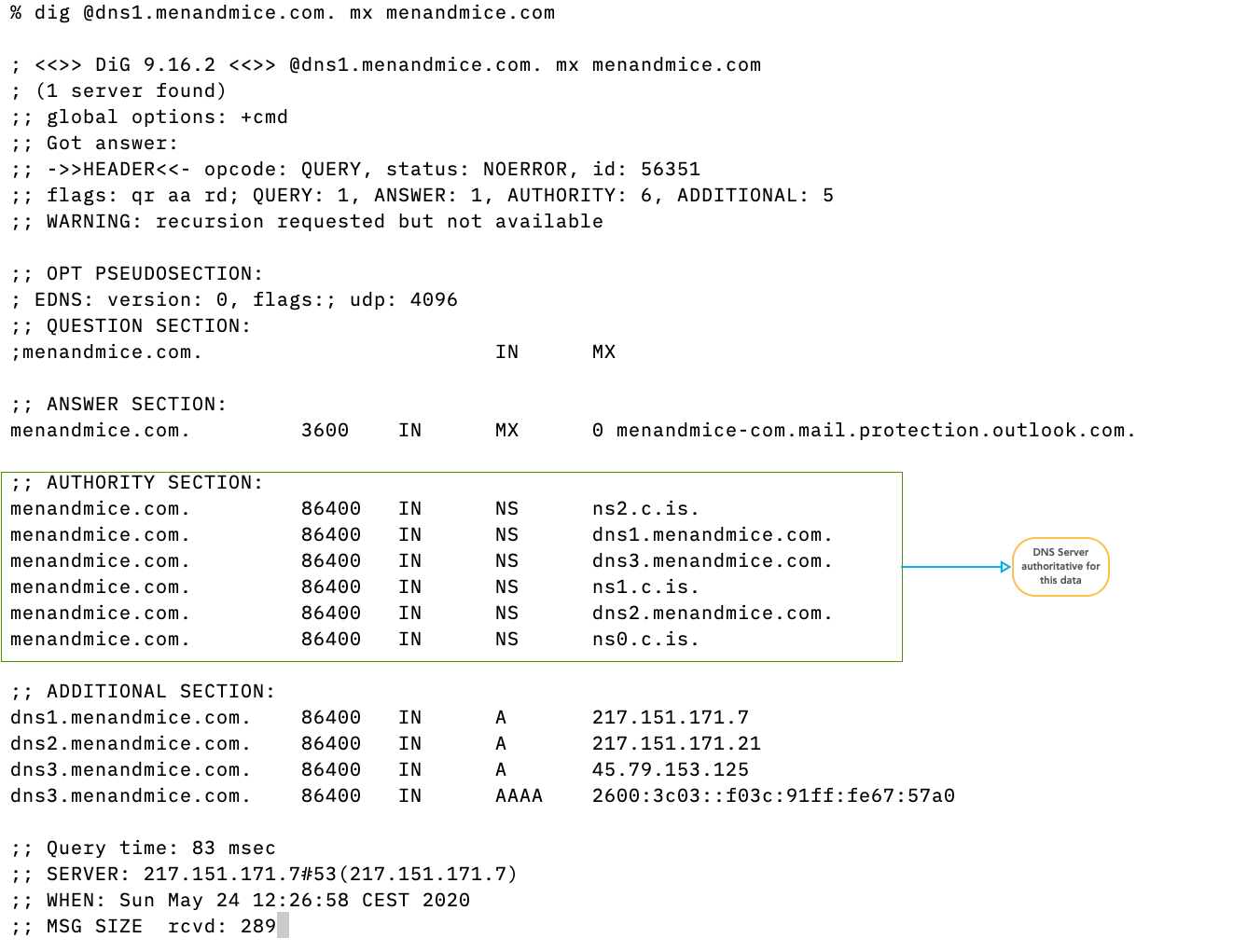
- If present, the authority section contains the authoritative name server that hosts the content delivered in the answer. For negative (NXDOMAIN/NOERROR-NODATA) answers, the authority section contains the SOA record of the zone that is authoritative for the negative answer.
3.5.1 Exercise
- Use
digto answer the following questions.- How many authoritative name-servers does the domain
twitter.comhave? Use a similar query as in the previous exercise
- How many authoritative name-servers does the domain
3.6 Additional Section
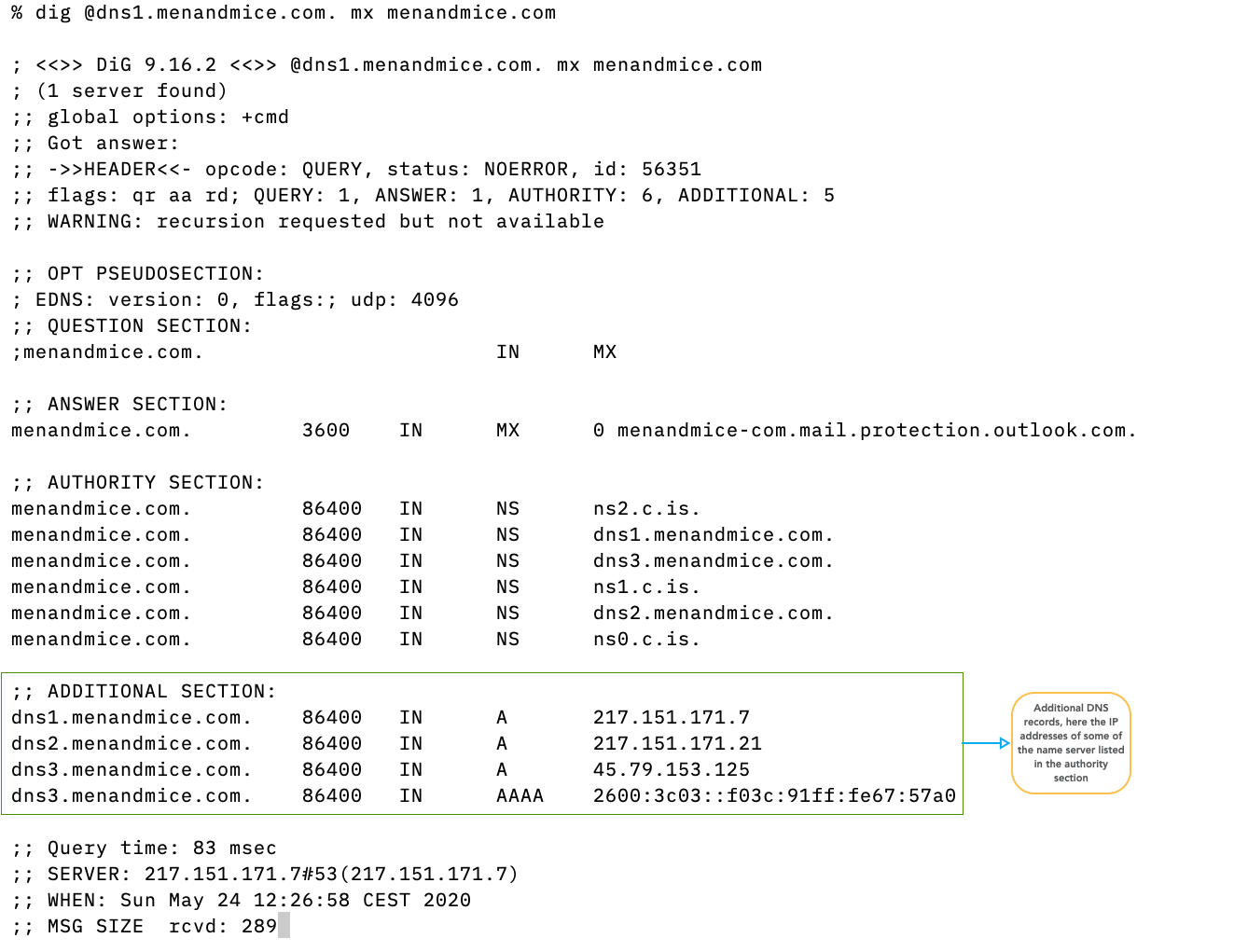
- If present, the additional section contains additional DNS records that have not been explicitly requested, but might help in the name resolution process. Because the additional section can be misused in attacks, modern DNS server software minimizes the additional section data.
- If EDNS data is available, it is also in the
additional section, but
digdisplays this data in the OPT pseudo-section
3.6.1 Exercise
- Use
digto answer the following questions.- How many records show in the additional section for the following
digquery?$ dig @ns.second-ns.com. mx hetzner.company
- How many records show in the additional section for the following
3.7 Footer
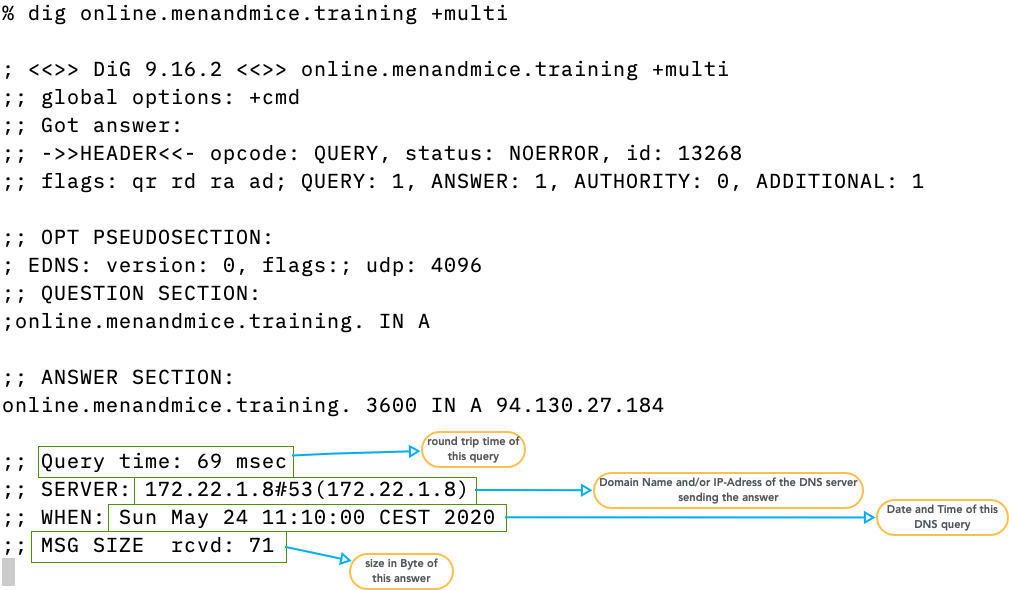
- The footer contains the size (in bytes) of the answer packet, the DNS server that has send the answer, the time it took to receive the answer and the time and date of the DNS communication
3.7.1 Exercise
- Use
digto answer the following questions.- How many bytes is the answer packet for
dig TXT twitter.com? - Which server delivers the answer?
- How many bytes is the answer packet for
3.8 Sending the query to a specific DNS server/resolver
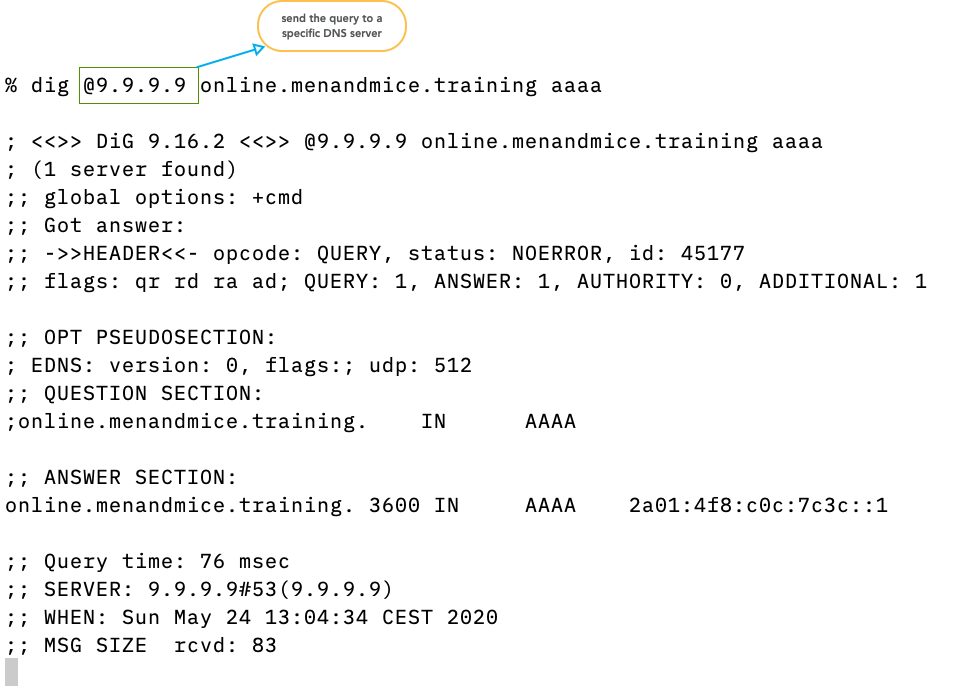
- Usually
digsends the query to the DNS resolver configured in the operating system (file/etc/resolv.confon Unix/Linux) - With the
@syntax the query can be sent to other DNS servers (resolver or authoritative server)
3.9 Sending non-recursive queries
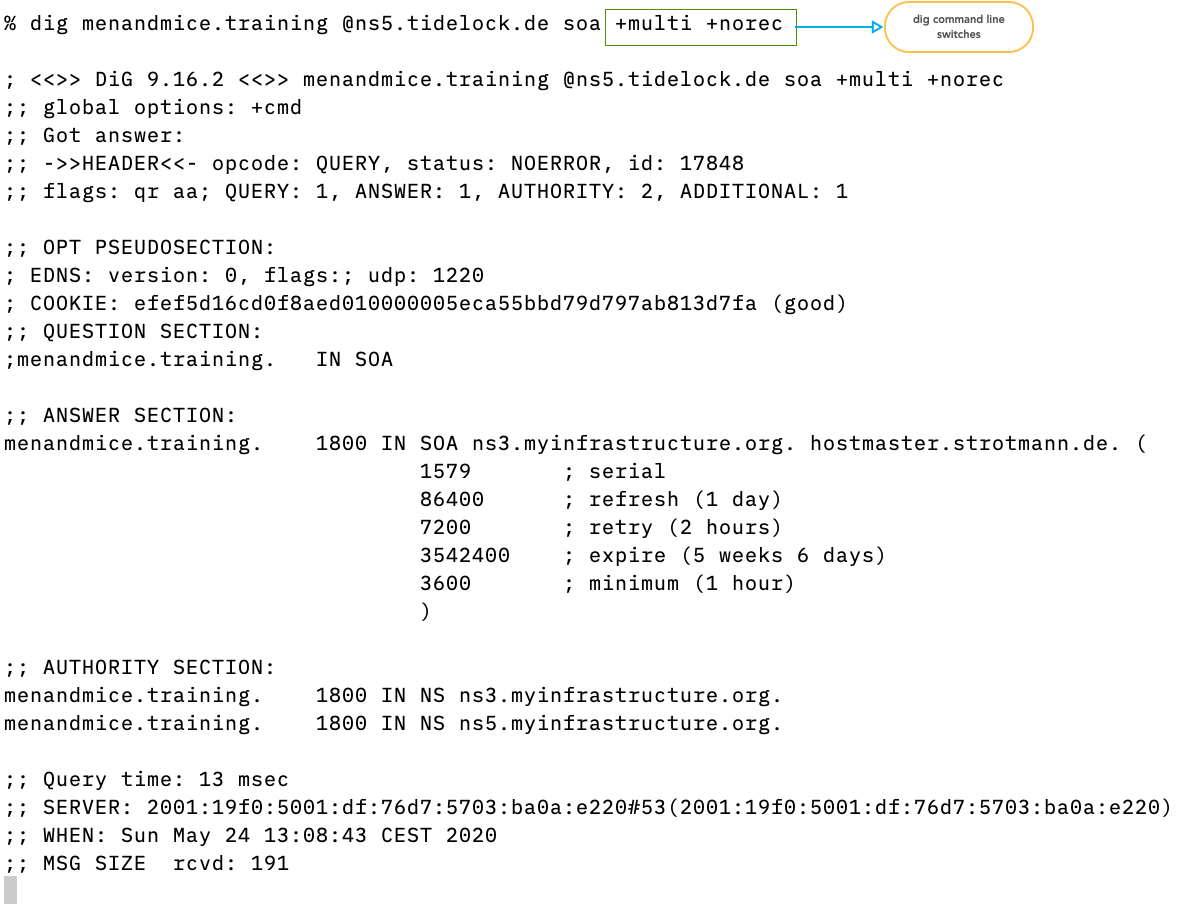
- Command line switches can alter the query sent by
dig.+multiformats the output in human readable form (wrapped for 80 column terminal)+norecsends a query withoutRDflag (non-recursive or iterative query)
3.10 Asking for DNSSEC data
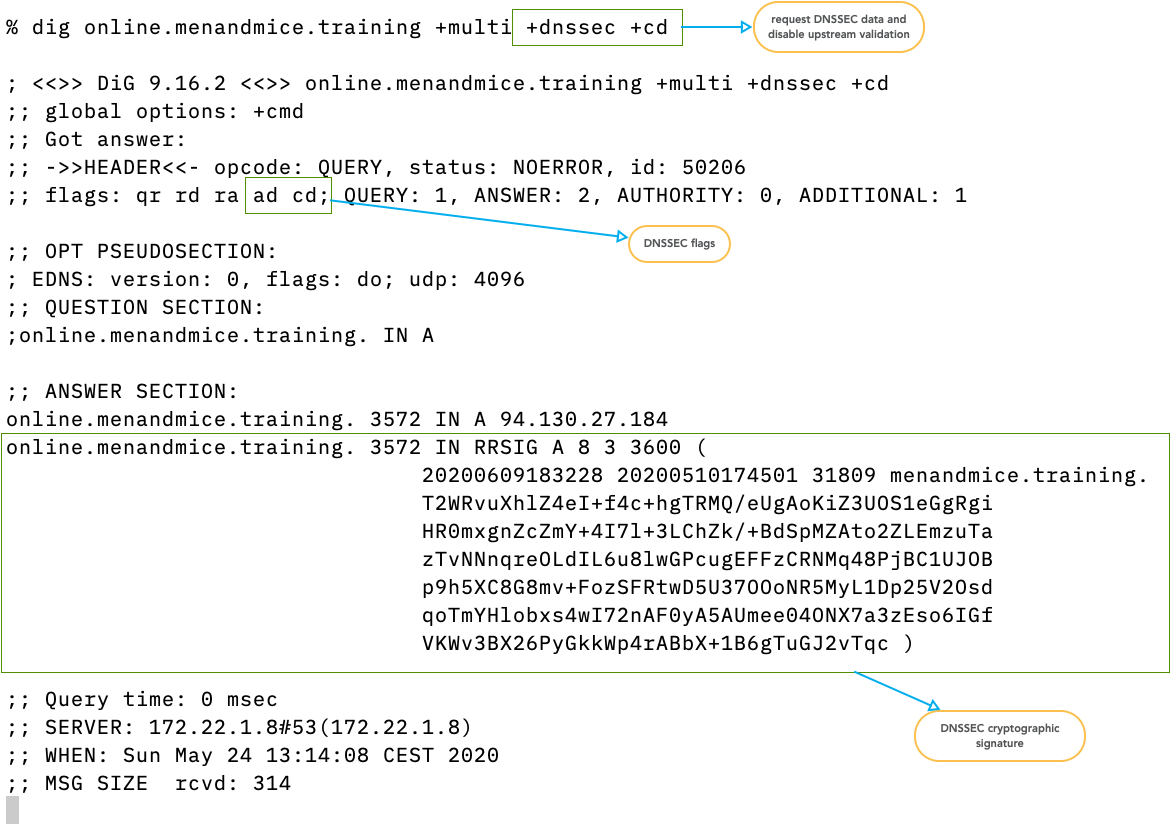
- The switch
+dnssecrequests DNSSEC data from the upstream server - The switch
+cdsends theCD(checking disabled) flag to disable upstream DNSSEC validation (if the target of the query is a DNS resolver)
4 DNSSEC troubleshooting
4.1 checking DNS resolution issues
4.1.1 dig
The DNS name resolution tool dig can be used to test the general
function of a DNS resolver, or to test if an error condition exist at
the remote DNS authoritative servers of a domain.
4.1.2 testing one DNS resolver over UDP
To test the general connectivity and operation of a DNS resolver, a
query for well known DNS data can be sent, such as for the list of
name-server (NS records) of the root zone ".". The answer should
contain the list of all 13 root name server in the Internet (with the
names a-m.root-servers.net)
$ dig @IP-of-DNS-resolver NS .
- What are reasons we recommend using the IP address of a resolver instead of its name?
4.1.3 Testing one DNS resolver over TCP
The DNS resolver should also be reachable over TCP, to send a query
via TCP the flag +tcp has to be appended to the query
$ dig @IP-of-DNS-resolver NS . +tcp
- You can save 33% typing by using
+vcinstead of+tcp. What doesvcdo? Check the manual page fordig(1).
4.1.4 Testing reachability of all authoritative DNS servers
The dig function +nssearch will first query all NS records for a
given domain and then will try to query directly (without going to a
DNS-resolver) the authoritative DNS servers of that domain:
$ dig @IP-of-DNS-resolver example.com +nssearch
The function will print out the SOA record of the zone (here
example.com) for each DNS server that has send an answer to the
query, including the SOA serial, the IPv4 and/or IPv6 address and the
round-trip-time (RTT) of the query.
All SOA serial numbers should show the same number, else there might be an issue with zone synchronization via zone transfer which might be a possible cause for DNS lookup problems.
- Which type of DNS servers (authoritative, recursive, primary, secondary) are at fault if the SOA serial numbers of a zone are not in sync? Who can correct the fault?
4.1.5 Testing the resolution chain
The function +trace in dig will trace the DNS name resolution
starting from the root DNS server system down to the requested name.
$ dig @IP-of-DNS-resolver example.com +trace
Only the very first query to find the root-server addresses will be done towards the DNS resolver given in the command, all other queries will be sent directly to the DNS resolver. This function tests and prints one of usually many possible DNS resolution paths. A successful return of the command does not indicate that the resolution path is without errors, it is only an indication that at least one successful path exists.
4.1.6 Testing for DNSSEC validation issues
If a DNS query returns a SERVFAIL answer, it can be a DNSSEC
validation issue at the DNS resolver, or it can be some kind of server
malfunction on the DNS resolver or the remote authoritative server.
In order the check for DNSSEC validation issues, the administrator can
send a DNS query with the +cd flag (Checking Disabled). With this
flag set, the DNS resolver will skip DNSSEC validation and will return
the DNS data to dig even in case the DNSSEC validation would fail.
So if a DNS query returns data when +cd is set, but returns
SERVFAIL when +cd is not set, this indicates a DNSSEC validation
issue. If the answer is always SERVFAIL, it is some other kind
of problem (usually not DNSSEC).
5 External web services to check DNS & DNSSEC
Several website services exist that help DNS administrators to check the health of a DNS system
5.1 Zonemaster
The website Zonemaster https://zonemaster.net is a collaboration between the French TLD registry Afnic and the Swedish registry IIS. The website takes a domain name and will generate a report of errors and best practice recommendations of the setup of this domain name.
5.2 DNSViz
DNSViz https://dnsviz.net is a tool for visualizing the status of a DNS zone. It provides a visual analysis of the DNSSEC authentication chain for a domain name and its resolution path in the DNS namespace, and it lists configuration errors detected by the tool.
6 Looking into DNSSEC validation issues
DNSEC validation issues are often a problem with misconfiguration at the authoritative DNS server side of the domain, not an issue of the DNS resolver system. However to be able to debug DNSSEC issues, for example to decide if an NTA (negative trust anchor) should be inserted into the DNS resolver system to temporarily disable DNSSEC validation for a specific domain, the DNSSEC validation issue should be investigated first.
6.1 DNSSEC validation troubleshooting with "delv"
The tool delv is part of the BIND 9 DNS server and implements a full
DNS resolver and DNSSEC validator inside the command line tool. This
tool works very similarly to dig (and shares the same command line
syntax), but where dig always needs a DNS resolver to get the DNS
information, delv can query the data and can validate the DNSSEC
information itself.
6.2 Message trace
The flag +mtrace enables the message tracing in delv, the tool
will print all DNS queries and answers during the processing of the
query.
$ delv example.com +mtrace
6.3 Validation trace
The flag +vtrace will print a debug trace of all DNSSEC validation
steps the tool will do in order to validate the received DNS answers
$ delv example.com +vtrace
6.4 DNSSEC path validation with drill
The tool drill is part of the LDNS tools (Debian/Ubuntu package
ldnsutils) and is a dig lookalike tool with additional
features. One notable feature is the function to trace the DNSSEC
validation and to print the DNSSEC chain-of-trust together with the
DNSSEC key information.
drill requires the current DNSSEC root trust anchor in a file to be
able to work. This trust anchor can be received with drill, but also
with dig or delve:
$ dig @a.root-servers.net . DNSKEY | grep 257 > root.key
This DNSSEC root trust-anchor key can be used to do a DNSSEC chain
chase with drill:
$ drill -SD -k root.key example.com
- In the example above we fetched the root DNSKEY with
dig. Is this method for obtaining the root DNSKEY record foolproof, and do you consider it secure?
7 Encrypted Transport
The IETF has introduced two main protocols over the last years to provide DNS transport encryption:
- DNS over TLS (DoT)
- DNS over HTTPS (DoH)
DoT and/or DoH are used in the Internet and might also be required for some security sensitive applications (see "Improve DNS security for apps and servers" from Apple WWDC 2022 https://developer.apple.com/videos/play/wwdc2022/10079/)
For Administrators, it is therefor important to know how to troubleshoot DoT and DoH services.
Both protocols are supported with dig version 9.18 and
up. Alternatively, the tools kdig from the Knot DNS Server can be
used. kdig works as a drop in replacement for dig and has similar
functions.
7.1 DNS over TLS
A DoT service can be reached on port 853.
To send a query over TLS protocol (DNS over TLS over TCP), use the
+tls command line switch
% dig @1.1.1.1 m3aawg.org A +tls ; <<>> DiG 9.18.3 <<>> @1.1.1.1 m3aawg.org A +tls ; (1 server found) ;; global options: +cmd ;; Got answer: ;; ->>HEADER<<- opcode: QUERY, status: NOERROR, id: 45617 ;; flags: qr rd ra; QUERY: 1, ANSWER: 1, AUTHORITY: 0, ADDITIONAL: 1 ;; OPT PSEUDOSECTION: ; EDNS: version: 0, flags:; udp: 1232 ; PAD: (409 bytes) ;; QUESTION SECTION: ;m3aawg.org. IN A ;; ANSWER SECTION: m3aawg.org. 300 IN A 34.214.179.220 ;; Query time: 30 msec ;; SERVER: 1.1.1.1#853(1.1.1.1) (TLS) ;; WHEN: Mon Jun 13 08:21:37 CEST 2022 ;; MSG SIZE rcvd: 468
The use of TLS as the transport is indicated in the footer line.
7.2 DNS over HTTPS
DoH does work on port 443 (classic https port) and can be multiplexed with other HTTPS data (it is possible to host both a web-site and a DNS-over-HTTPS service on the same port.
The idea of DoH is to provide extra privacy by transport encryption and by hiding the DNS requests inside the HTTPS stream (web-data).
To send a DNS query over HTTPS protocol (DNS over HTTP over TLS over
TCP), use the +https command line switch
% dig @1.1.1.1 m3aawg.org A +https ; <<>> DiG 9.18.3 <<>> @1.1.1.1 m3aawg.org A +https ; (1 server found) ;; global options: +cmd ;; Got answer: ;; ->>HEADER<<- opcode: QUERY, status: NOERROR, id: 10673 ;; flags: qr rd ra; QUERY: 1, ANSWER: 1, AUTHORITY: 0, ADDITIONAL: 1 ;; OPT PSEUDOSECTION: ; EDNS: version: 0, flags:; udp: 1232 ;; QUESTION SECTION: ;m3aawg.org. IN A ;; ANSWER SECTION: m3aawg.org. 300 IN A 34.214.179.220 ;; Query time: 16 msec ;; SERVER: 1.1.1.1#443(1.1.1.1) (HTTPS) ;; WHEN: Mon Jun 13 08:25:12 CEST 2022 ;; MSG SIZE rcvd: 55
The use of HTTPS as the transport is indicated in the footer line.
8 Check Scripts
8.1 Script to check DNS resolver functions
8.2 Script to check authoritative Server and Zones
At https://github.com/sys4/m3aawg-dns-and-dnssec-debugging we are providing a set of simple shell scripts that will test DNS resolver or the setup of authoritative DNS servers for a zone.
These scripts are always work in progress and will be expanded in the future (check the repo). Pull requests are very welcome.
The scripts can be used as templates to build your own DNS monitoring.
The scripts are also a lightweight on-prem alternative to the web tools.
8.3 DNS resolver check
Below is an example inocation of the DNS resolver check script. The argument is the IPv6 (or IPv4) address of an DNS resolver
% bash ./dnsresolver-check.sh 194.25.0.52 query A-Record over IPv4/UDP: [ OK ] query AAAA-Record over IPv4/UDP: [ OK ] query A-Record over IPv4/TCP: [ OK ] query AAAA-Record over IPv4/TCP: [ OK ] query A-Record over TLS: [FAILED] query A-Record over HTTPS: [FAILED] verify response > 512 byte (classic DNS limit for UDP): [ OK ] verify response > 1232 byte (2020 DNS Flag Day limit): [ OK ] verify response > 1500 byte (Ethernet MTU limit for UDP): [ OK ] verify response > 4096 byte (EDNS max limit for UDP): [ OK ] verify DNSSEC validation of the root zone [ OK ] verify DNSSEC validation of com TLD zone [ OK ] verify DNSSEC validation of net TLD zone [ OK ] verify DNSSEC validation of org TLD zone [ OK ] verify DNSSEC validation of de ccTLD zone [ OK ] verify DNSSEC validation of se ccTLD zone [ OK ] verify DNSSEC validation of cz ccTLD zone [ OK ] verify DNSSEC validation of xyz nTLD zone [ OK ] verify DNSSEC validation of onl nTLD zone [ OK ] verify DNSSEC validation of nrw nTLD zone [ OK ] verify DNSSEC validation with RSA-SHA256 [ OK ] verify DNSSEC validation with RSA-SHA512 [ OK ] verify DNSSEC validation with ECDSA256 [ OK ] verify DNSSEC validation with ECDSA384 [ OK ] non validation of record with expired RRSIG [ OK ] non validation of record with RRSIG to DNSKEY mismatch [ OK ] non validation of record with DNSKEY to DS record mismatch[ OK ] verify DNSSEC validation of TLSA record [ OK ] verify DNSSEC validation of NXDOMAIN answer [ OK ] verify DNSSEC validation of NODATA answer [ OK ] rebind protection [FAILED]
8.4 DNS Zone check
The DNS zone check script will take the name of a DNS zone and will execute a number of tests against the authoritative DNS servers for this zone:
% bash ./dnsauth-check.sh dnssec.works Testing zone dnssec.works... Testing UDPv4 Test UDPv4 ns5.myinfrastructure.org. for dnssec.works: [ OK ] Test UDPv4 ns3.myinfrastructure.org. for dnssec.works: [ OK ] Testing UDPv6 Test UDPv6 ns3.myinfrastructure.org. for dnssec.works: [ OK ] Test UDPv6 ns5.myinfrastructure.org. for dnssec.works: [ OK ] Testing TCPv4 Test UDPv4 ns3.myinfrastructure.org. for dnssec.works: [ OK ] Test UDPv4 ns5.myinfrastructure.org. for dnssec.works: [ OK ] Testing TCPv6 Test UDPv6 ns3.myinfrastructure.org. for dnssec.works: [ OK ] Test UDPv6 ns5.myinfrastructure.org. for dnssec.works: [ OK ] Testing EDNS Response Size (Policy: 1232 bytes) Test ns3.myinfrastructure.org. for dnssec.works: [ OK ] Test ns5.myinfrastructure.org. for dnssec.works: [FAILED] Test Parent - Child Delegation Test delegation for dnssec.works [ OK ]
8.5 Exercise
- Login to your virtual lab machine
- Clone the check scripts
% git clone https://github.com/sys4/m3aawg-dns-and-dnssec-debugging
- Find the IP-Address(es) of the DNS resolver in the VM hosting
environment
% cat /etc/resolv.conf
- Change into the script directory
% cd m3aawg-dns-and-dnssec-debugging/
- Execute the resolver check script against the DNS resolver(s) IP-addres(es)
- Execute the DNS zone check script against a domain
(e.g.
m3aawg.org)
9 'dig'ing deeper
This extra chapter explains some additional useful command line
switches for the dig tool
9.1 dig
dig's default output is divided into seven sections. Not every section is shown with each dig command.
- cmd (initial comment)
- comment
- question (the query)
- answer
- authority
- additional
- stats
9.2 dig Query Options
- The sections are toggled to appear or be hidden with query options.
- Query options begin with a
+. - All query options can be disabled with
+noall, then individual options can be re-enabled.$ dig +noall server01.dnslab.org
- Query options begin with a
9.3 dig +[no]cmd
- The initial comment (cmd) section shows the dig version number and query options.
$ dig +noall +cmd server01.dnslab.org ; <<>> DiG 9.10.3 <<>> server01.dnslab.org +noall +cmd ;; global options: +cmd
9.4 dig +[no]stats
- stats is the last section displayed.
- It shows the time for the query, the server queried, and the
total size of the response packet.
$ dig +noall server01.dnslab.org +stats ;; Query time: 7 msec ;; SERVER: 192.168.53.251#53(192.168.53.251) ;; WHEN: Wed Nov 25 12:55:36 UTC 2015 ;; MSG SIZE rcvd: 92
- It shows the time for the query, the server queried, and the
total size of the response packet.
- run a
dig +noall +answer +stats sys4.deWhat could be reasons fordigto outputSERVERand a date/time stamp in the output?
9.5 dig +nocmd +nostats
- The output of dig gets considerably smaller without the first and last sections (initial comment & stats).
$ dig +nocmd +nostats ns01a.dnslab.org ;; Got answer: ;; ->>HEADER<<- opcode: QUERY, status: NOERROR, id: 21736 ;; flags: qr rd ra ad; QUERY: 1, ANSWER: 1, AUTHORITY: 0, ADDITIONAL: 1 ;; OPT PSEUDOSECTION: ; EDNS: version: 0, flags:; udp: 512 ;; QUESTION SECTION: ;ns01a.dnslab.org. IN A ;; ANSWER SECTION: ns01a.dnslab.org. 60 IN A 178.128.233.110
9.6 dig +comment
- The comment section comes after the cmd (initial comment) section.
- It shows all message fields except the four with RRs.
- RCODE is listed as status.
$ dig +noall server01.dnslab.org +comment ;; Got answer: ;; ->>HEADER<<- opcode: QUERY, status: NOERROR, id: 42739 ;; flags: qr rd ra ad; QUERY: 1, ANSWER: 1, AUTHORITY: 0, ADDITIONAL: 1 ;; OPT PSEUDOSECTION: ; EDNS: version: 0, flags:; udp: 512
9.7 dig +nocomment
- The option
+nocommentremoves the comments section, and comments before other sections.$ dig +nocmd +nostats ns01a.dnslab.org | grep SECTION ;; OPT PSEUDOSECTION: ;; QUESTION SECTION: ;; ANSWER SECTION: $ dig +nocmd +nostats ns01a.dnslab.org +nocomment | grep SECTION $
9.8 dig +question
- The question section shows the query as it appears in the response message.
$ dig +noall +question ns01a.dnslab.org ;ns01a.dnslab.org. IN A
9.9 dig +answer
- The answer section shows the query response in standard Master
File Format.
$ dig +noall +answer ns01a.dnslab.org ns01a.dnslab.org. 36 IN A 178.128.233.110
9.10 dig +authority
- The authority section shows the authority section in the query
response.
$ dig +noall +authority ns01a.zone100.dnslab.org @localhost zone100.dnslab.org. 30 IN SOA ns01a.dnslab.org. hostmaster.zone100.dnslab.org. 1001 3600 1800 3542400 30
9.11 dig +additional
- The additional section shows the additional section in the query response.
- The
OPTpseudo-header for EDNS is sent in the additional section, but not displayed there by dig.- It is in the comments section.
$ dig +noall +additional ns01a.dnslab.org $
- It is in the comments section.
9.12 dig +qr
- By default,
digshows the response message.- The
+qroption adds the outgoing query. - The query is shown after the text:
"Sending:"$ dig +qr ns01a.dnslab.org ; <<>> DiG 9.11.13-RedHat-9.11.13-6.el8_2.1 <<>> +qr ns01a.dnslab.org ;; global options: +cmd ;; Sending: ;; ->>HEADER<<- opcode: QUERY, status: NOERROR, id: 57808 ;; flags: rd ad; QUERY: 1, ANSWER: 0, AUTHORITY: 0, ADDITIONAL: 1 ;; OPT PSEUDOSECTION: ; EDNS: version: 0, flags:; udp: 4096 ; COOKIE: 7c29201b7c89b54e ;; QUESTION SECTION: ;ns01a.dnslab.org. IN A ;; QUERY SIZE: 55 ;; Got answer: ;; ->>HEADER<<- opcode: QUERY, status: NOERROR, id: 57808 ;; flags: qr rd ra ad; QUERY: 1, ANSWER: 1, AUTHORITY: 0, ADDITIONAL: 1 ;; OPT PSEUDOSECTION: ; EDNS: version: 0, flags:; udp: 512 ;; QUESTION SECTION: <OUTPUT SUPPRESSED>
- The
9.13 dig +short
+shortdisables the default output. It shows only the response's RDATA.- Contrast
+short, to+answer, which displays the entire RRSet.$ dig +short ns01a.dnslab.org 192.168.53.101 $ dig +noall +answer ns01a.dnslab.org ns01a.dnslab.org. 30 IN A 192.168.53.101
- Contrast
9.14 Truncate & dig +ignore
- The response displayed by
digis the last received.- If a message returns with
tcset, the query is resent with TCP. (Therefore,tcis rarely seen in dig output.) - The
+ignoreflag tells dig to not re-query with TCP (Example below.) - When
digre-queries with TCP, a message is displayed that can't be suppressed.$ dig +noall dnslab.org DNSKEY +dnssec ;; Truncated, retrying in TCP mode. $
- If a message returns with
- The response is too big, but dig doesn't re-query with TCP.
$ dig dnslab.org dnskey +dnssec +ignore ; <<>> DiG 9.9.4 <<>> dnslab.org dnskey +dns +ignore ;; global options: +cmd ;; Got answer: ;; ->>HEADER<<- opcode: QUERY, status: NOERROR, id: 20521 ;; flags: qr tc rd ra ad; QUERY: 1, ANSWER: 0, AUTHORITY: 0, ADDITIONAL: 1 ;; OPT PSEUDOSECTION: ; EDNS: version: 0, flags: do; udp: 800 ;; QUESTION SECTION: ;dnslab.org. IN DNSKEY ;; Query time: 9 msec ;; SERVER: 192.168.53.251#53(192.168.53.251) ;; WHEN: Wed Nov 25 14:05:05 UTC 2015 ;; MSG SIZE rcvd: 39